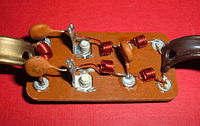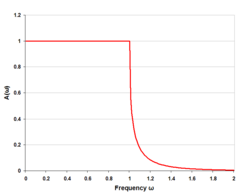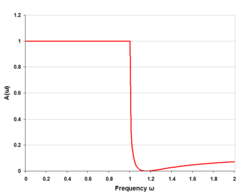Electronic filter

Electronic filters are electronic circuits which perform signal processing functions, specifically intended to remove unwanted signal components and/or enhance wanted ones. Electronic filters can be:
- passive or active
- analog or digital
- discrete-time (sampled) or continuous-time
- linear or non-linear
- infinite impulse response (IIR type) or finite impulse response (FIR type)
The most common types of electronic filters are linear filters, regardless of other aspects of their design. See the article on linear filters for details on their design and analysis.
Contents |
History
The oldest forms of electronic filters are passive analog linear filters, constructed using only resistors and capacitors or resistors and inductors. These are known as RC and RL single pole filters respectively. More complex multipole LC filters have also existed for many years and the operation of such filters is well understood with many books having been written about them.
Hybrid filters have also been made, typically involving combinations of analog amplifiers with mechanical resonators or delay lines. Other devices such as CCD delay lines have also been used as discrete-time filters. With the availability of digital signal processing, active digital filters have become common.
Classification by technology
Passive filters
Passive implementations of linear filters are based on combinations of resistors (R), inductors (L) and capacitors (C). These types are collectively known as passive filters, because they do not depend upon an external power supply.
Inductors block high-frequency signals and conduct low-frequency signals, while capacitors do the reverse. A filter in which the signal passes through an inductor, or in which a capacitor provides a path to ground, presents less attenuation to low-frequency signals than high-frequency signals and is a low-pass filter. If the signal passes through a capacitor, or has a path to ground through an inductor, then the filter presents less attenuation to high-frequency signals than low-frequency signals and is a high-pass filter. Resistors on their own have no frequency-selective properties, but are added to inductors and capacitors to determine the time-constants of the circuit, and therefore the frequencies to which it responds.
The inductors and capacitors are the reactive elements of the filter. The number of elements determines the order of the filter. In this context, an LC tuned circuit being used in a band-pass or band-stop filter is considered a single element even though it consists of two components.
At high frequencies (above about 100 megahertz), sometimes the inductors consist of single loops or strips of sheet metal, and the capacitors consist of adjacent strips of metal. These inductive or capacitive pieces of metal are called stubs.
Single element types

The simplest passive filters consist of a single reactive element. These are constructed of RC, RL, LC or RLC elements.
The quality or "Q" factor is a measure that is sometimes used to describe simple band-pass or band-stop filters. A filter is said to have a high Q if it selects or rejects a range of frequencies that is narrow in comparison to the centre frequency. Q may be defined as the ratio of centre frequency divided by 3dB bandwidth. It is not commonly employed with higher order filters where other parameters are of more concern.
L filter
An L filter consists of two reactive elements, one in series and one in parallel.
T and π filters


Three-element filters can have a 'T' or 'π' topology and in either geometries, a low-pass, high-pass, band-pass, or band-stop characteristic is possible. The components can be chosen symmetric or not, depending on the required frequency characteristics. The high-pass T filter in the illustration, has a very low impedance at high frequencies, and a very high impedance at low frequencies. That means that it can be inserted in a transmission line, resulting in the high frequencies being passed and low frequencies being reflected. Likewise, for the illustrated low-pass π filter, the circuit can be connected to a transmission line, transmitting low frequencies and reflecting high frequencies.
Multiple element types
Multiple element filters are usually constructed as a ladder network. These can be seen as a continuation of the L,T and π designs of filters. More elements are needed when it is desired to improve some parameter of the filter such as stop-band rejection or slope of transition from pass-band to stop-band.
Active filters
Active filters are implemented using a combination of passive and active (amplifying) components, and require an outside power source. Operational amplifiers are frequently used in active filter designs. These can have high Q, and can achieve resonance without the use of inductors. However, their upper frequency limit is limited by the bandwidth of the amplifiers used.
Digital filters

Digital signal processing allows the inexpensive construction of a wide variety of filters. The signal is sampled and an analog to digital converter turns the signal into a stream of numbers. A computer program running on a CPU or a specialized DSP (or less often running on a hardware implementation of the algorithm) calculates an output number stream. This output can be converted to a signal by passing it through a digital to analog converter. There are problems with noise introduced by the conversions, but these can be controlled and limited for many useful filters. Due to the sampling involved, the input signal must be of limited frequency content or aliasing will occur. See also: Digital filter.
Other filter technologies
Quartz filters and piezoelectrics
In the late 1930s, engineers realized that small mechanical systems made of rigid materials such as quartz would acoustically resonate at radio frequencies, i.e. from audible frequencies (sound) up to several hundred megahertz. Some early resonators were made of steel, but quartz quickly became favored. The biggest advantage of quartz is that it is piezoelectric. This means that quartz resonators can directly convert their own mechanical motion into electrical signals. Quartz also has a very low coefficient of thermal expansion which means that quartz resonators can produce stable frequencies over a wide temperature range. Quartz crystal filters have much higher quality factors than LCR filters. When higher stabilities are required, the crystals and their driving circuits may be mounted in a "crystal oven" to control the temperature. For very narrow band filters, sometimes several crystals are operated in series.
Engineers realized that a large number of crystals could be collapsed into a single component, by mounting comb-shaped evaporations of metal on a quartz crystal. In this scheme, a "tapped delay line" reinforces the desired frequencies as the sound waves flow across the surface of the quartz crystal. The tapped delay line has become a general scheme of making high-Q filters in many different ways.
SAW filters
SAW (surface acoustic wave) filters are electromechanical devices commonly used in radio frequency applications. Electrical signals are converted to a mechanical wave in a piezoelectric crystal; this wave is delayed as it propagates across the crystal, before being converted back to an electrical signal by further electrodes. The delayed outputs are recombined to produce a direct analog implementation of a finite impulse response filter. This hybrid filtering technique is also found in an analog sampled filter. SAW filters are limited to frequencies up to 3 GHz.
BAW filters
BAW (Bulk Acoustic Wave) filters are electromechanical devices. BAW filters can implement ladder or lattice filters. BAW filters typically operate at frequencies from around 2 to around 16 GHz, and in may be smaller or thinner than equivalent SAW filters. Two main variants of BAW filters are making their way into devices, Thin film bulk acoustic resonator or FBAR and Solid Mounted Bulk Acoustic Resonators.
Garnet filters
Another method of filtering, at microwave frequencies from 800 MHz to about 5 GHz, is to use a synthetic single crystal yttrium iron garnet sphere made of a chemical combination of yttrium and iron (YIGF, or yttrium iron garnet filter). The garnet sits on a strip of metal driven by a transistor, and a small loop antenna touches the top of the sphere. An electromagnet changes the frequency that the garnet will pass. The advantage of this method is that the garnet can be tuned over a very wide frequency by varying the strength of the magnetic field.
Atomic filters
For even higher frequencies and greater precision, the vibrations of atoms must be used. Atomic clocks use caesium masers as ultra-high Q filters to stabilize their primary oscillators. Another method, used at high, fixed frequencies with very weak radio signals, is to use a ruby maser tapped delay line.
The transfer function
The transfer function  of a filter is the ratio of the output signal
of a filter is the ratio of the output signal  to that of the input signal
to that of the input signal  as a function of the complex frequency
as a function of the complex frequency  :
:
with  .
.
The transfer function of all linear time-invariant filters generally share certain characteristics:
- Since the filters are constructed of discrete components, their transfer function will be the ratio of two polynomials in
 , i.e. a rational function of
, i.e. a rational function of  . The order of the transfer function will be the highest power of
. The order of the transfer function will be the highest power of  encountered in either the numerator or the denominator.
encountered in either the numerator or the denominator. - The polynomials of the transfer function will all have real coefficients. Therefore, the poles and zeroes of the transfer function will either be real or occur in complex conjugate pairs.
- Since the filters are assumed to be stable, the real part of all poles (i.e. zeroes of the denominator) will be negative, i.e. they will lie in the left half-plane in complex frequency space.
The proper construction of a transfer function involves the Laplace transform, and therefore it is needed to assume null initial conditions, because
And when f(0)=0 we can get rid of the constants and use the usual expression
An alternative to transfer functions is to give the behavior of the filter as a convolution. The convolution theorem, which holds for Laplace transforms, guarantees equivalence with transfer functions.
Classification by transfer function
Filters may be specified by family and passband. A filter's family is specified by certain design criteria which give general rules for specifying the transfer function of the filter. Some common filter families and their particular design criteria are:
- Butterworth filter - no gain ripple in pass band and stop band, slow cutoff
- Chebyshev filter(Type I) - no gain ripple in stop band, moderate cutoff
- Chebyshev filter(Type II) - no gain ripple in pass band, moderate cutoff
- Bessel filter - no group delay ripple, no gain ripple in both bands, slow gain cutoff
- Elliptic filter - gain ripple in pass and stop band, fast cutoff
- Optimum "L" filter
- Gaussian filter - no ripple in response to step function
- Hourglass filter
- Raised-cosine filter
Generally, each family of filters can be specified to a particular order. The higher the order, the more the filter will approach the "ideal" filter. The ideal filter has full transmission in the pass band, and complete attenuation in the stop band, and the transition between the two bands is abrupt (often called brick-wall).
Here is an image comparing Butterworth, Chebyshev, and elliptic filters. The filters in this illustration are all fifth-order low-pass filters. The particular implementation -- analog or digital, passive or active -- makes no difference; their output would be the same.

As is clear from the image, elliptic filters are sharper than all the others, but they show ripples on the whole bandwidth.
Each family can be used to specify a particular pass band in which frequencies are transmitted, while frequencies in the stop band (i.e. outside the pass band) are more or less attenuated.
- Low-pass filter - Low frequencies are passed, high frequencies are attenuated.
- High-pass filter - High frequencies are passed, Low frequencies are attenuated.
- Band-pass filter - Only frequencies in a frequency band are passed.
- Band-stop filter - Only frequencies in a frequency band are attenuated.
- All-pass filter - All frequencies are passed, but the phase of the output is modified.
The family and passband of a filter completely specify the transfer function of a filter. The transfer function completely specifies the behavior of a linear filter, but not the particular technology used to implement it. In other words, there are a number of different ways of achieving a particular transfer function when designing a circuit. A particular pass band filter can be obtained by transformation of a prototype filter of that class.
Classification by topology
Electronic filters can be classified by the technology used to implement them. Filters using passive filter and active filter technology can be further classified by the particular electronic filter topology used to implement them.
Any given filter transfer function may be implemented in any electronic filter topology.
Some common circuit topologies are:
- Cauer topology - Passive
- Sallen Key topology - Active
- Multiple Feedback topology - Active
- State Variable Topology - Active
- Biquadratic topology biquad filter - Active
Classification by design methodology
| Linear analog electronic filters |
|---|
|
Network synthesis filters
Image impedance filters
Simple filters
|
| edit |
Historically, linear analog filter design has evolved through three major approaches. The oldest designs are simple circuits where the main design criterion was the Q factor of the circuit. This reflected the radio receiver application of filtering as Q was a measure of the frequency selectivity of a tuning circuit. From the 1920s filters began to be designed from the image point of view, mostly being driven by the requirements of telecommunications. After World War II the dominant methodology was network synthesis. The higher mathematics used originally required extensive tables of polynomial coefficient values to be published but modern computer resources have made that unnecessary.[1]
Direct circuit analysis
Low order filters can be designed by directly applying basic circuit laws such as Kirchoff's laws to obtain the transfer function. This kind of analysis is usually only carried out for simple filters of 1st or 2nd order.

Image impedance analysis
This approach analyses the filter sections from the point of view of the filter being in an infinite chain of identical sections. It has the advantages of simplicity of approach and the ability to easily extend to higher orders. It has the disadvantage that accuracy of predicted responses rely on filter terminations in the image impedance, which is usually not the case.[2]




Network synthesis
The network synthesis approach starts with a required transfer function and then expresses that as a polynomial equation of the input impedance of the filter. The actual element values of the filter are obtained by continued-fraction or partial-fraction expansions of this polynomial. Unlike the image method, there is no need for impedance matching networks at the terminations as the effects of the terminating resistors are included in the analysis from the start.[2]
See also
|
|
External links and references
-
- Zverev, Anatol, I (1969). Handbook of Filter Synthesis. John Wiley & Sons. ISBN 0-471-98680-1. Catalog of passive filter types and component values. The Bible for practical electronic filter design.
- Williams, Arthur B & Taylor, Fred J (1995). Electronic Filter Design Handbook. McGraw-Hill. ISBN 0-07-070441-4.
- National Semiconductor AN-779 application note describing analog filter theory
- Fundamentals of Electrical Engineering and Electronics - Detailed explanation of all types of filters
- BAW filters (in French; PDF)
- Some Interesting Filter Design Configurations & Transformations
- Books and tutorials how to design RF Filters
- Analog Filters for Data Conversion


